Maps of the Antique
Mediterranean Sea
 Greece Greece
 Overview Overview
 Some dates Some dates
 Archaeological sites Archaeological sites
 Museums Museums
 Coinage Coinage
 Language and Writing Language and Writing
 Attic Attic
 Corinth Corinth
 Magna Graecia Magna Graecia
 Apulia Apulia
 Daunia Daunia
 Gnathia Gnathia
 Campania Campania
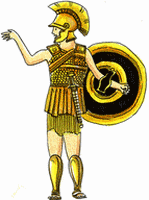
|
GREEK COINAGE
Greek coins are among the most attractive ancient artefacts. There are many reasons for this:
They are the oldest currencies in the world, and this gives them a particular aura.
They are real artworks created by talented artists, and hand-crafted: each coin is unique.
The benchmarks are numerous enough so that a non-specialist is not lost: each city minted its own coins, but marked them with its most significant symbols, which remained famous and extremely evocative until today: the Athenian owl is still present on the Greek euros!
A world to be discovered for the collector, who shall however have to remain humble: rare coins reach often high prices. Fortunately, the most beautiful ones are not necessarily the rarest.
Ancient Greek coins: 1000 years of history
The first Greek coins appeared in the VIIth century B.C., and the last ones during the reign of the Roman Emperor Gallienus (253-268 A.D.). The Greek coinage thus spans over a whole millenium.
As for greek history and art, the numismatists distinguish:
- the archaic period which extends from the beginning of Greek coinage to the Persian Wars (480 B.C.),
- the classical period, which starts then and ends with Alexandre the Great, about 330 B.C.,
- the hellenistic period, which lasts until the Roman conquest at the Ist century B.C.
The Greek cities continued to produce their own coins under the Roman domination up to the reign of Gallien: these coins are called “Greek provincial currencies”.
Croeseids, the coins of king Croesus
According to tradition, the oldest currencies date back to the kings of Lydia, whose richness was proverbial. The names of the Pactolus, the gold bearing stream and king Croesus still evoque richness.
In that time, a coin is a mass of metal – first electrum, a natural alloy of silver and gold and then, when it became possible to separated these metals under the reign of Croesus (561-547 B.C.), gold coins on one hand, silver coins on the other hand.
The value of the currency was that of the metal weight, which was marked using a hammer (lion, bull…). Apart rare exceptions, these currencies did not show any text.
During the VIIth and VIth century, this invention was adopted by the Greeks, and in particular in Aegina, where silver coins representing a turtle were produced as from 670 B.C. It spread very quickly over all the Greek world, including the numerous colonies of the Black Sea and Magna-Graecia.
Archaic Greek coins
Archaic coins are small masses of metal (gold, silver or bronze) on which symbol or patterns have been struck, in order to indicate their city of origin. The relief of the coins was engraved in hollow metal dies, then the rough metal blank was inserted between both dies, and the upper die was struck with a hammer. This operation required a certain skill so that the relief image appears clearly on a well centered coin.
Archaic coins from the cities from Asia Minor represent real or fantastic animals which are the emblem of the city: a tuna or a winged wild boar for Kyzikos, a seal for Phokea, a bull for Samos, a stag or a bee for Ephesos, etc
The coins from the most powerful cities circulated most largely, and thus imposed their weight unit, whereas weight units were generally different from one city to another. The silver drachma of Aegina (6,28 grams) was the first example of a currency which established itself as a monetary standard in commercial trade. About 510 B.C., Athens started to expand its wealth. The most famous coin was the silver tetradrachm (a 4 drachms coin). One attic drachm was equivalent to 4,36 grams silver and could be divided into 6 obols.
Little by little, the Athenian standard asserted itself. Tetradrachms using the attic standard were the most used currency il all the antiquity, even under Alexandre the Great and the hellenistic kings.
Greek coins of the classical period
During the classical period, Greek coinages reached an exceptional technical and artistic level. Many silver and gold currencies were circulating. They generally represented the tutelar divinity of the city, a legendary hero or a symbol of the city. On the coins of Rhodos, for example, a rose is stamped. The coins started to wear inscriptions, and first the name of the city.
Coins of the hellenistic period
During the hellenistic period, the Greek culture expanded widely. The tetradrachm with the head of Alexander the Great became an almost worldwide standard.
Kingdoms of Greek culture appeared in Egypt, in Syria, in Iran, in Afghanistan and in the northwest of India. Their currencies were mass-produced.
The main hellenistic innovation in coinage is the representation kings by lifelike portraits, with an inscription of their name. The coins even show sometimes the name of the minting workshop.
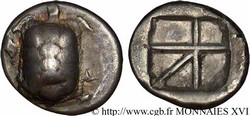
Aegina, ca. 400 B.C., stater, silver, diameter 21,50mm
|
AEGINA
According to mythology, the invention of the greek continental currency was made by Phidion of Argos in the VIIth century B.C. Actually, the production of the coins, the eginetic tortoises, would not have started before the second half of the VIth century B.C. This coinage comprises two phases, the first one using sea turtles - until 457 B.C. - and the second terrestrial turtle.
The city is located on the island also named Aegina, half way between Athens and the coast of Argolid. The first coins of the western world were minted there in the VIth century B.C.
Its geographical location and economic wealth were to make it a trading place of major importance, at the crossroads between Euboea, Athens, Corinth and the Peloponnese. The Aeginetic standard spread quickly all over the Egean Sea, Greece, Crete and part of Asia Minor.
Unfortunately, after the Persian Wars, the city was outshined by Athens which took it over in 457 B.C. The Aeginians were driven out by the Athenians. Aegina recovered its freedom only after the fall of Athens, but it had definitively lost its economic might.
Document CGB, www.cgb.fr |
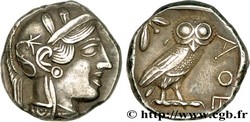
Attic, Athens, ca. 420-405 B.C., tetradrachm, silver, diameter 24,5mm |
ATHENS
The fortune of Athens in the Vth century rests mainly on the seizing of the Delian League’s treasure which contained no less than less than five thousand talents of silver and which was used for enriching and embellishing Athens while oppressing its allies. The Peloponnesian War (431-404 B.C.) puts an end to the Athenian hegemony. Pericles (449-429 B.C.) did not live long enough to attend the fall of the city. Thucydides immortalized this conflict in its work dedicated to the Peloponnesian War, to which he took part before being himself ostracized, which means banned. Document CGB, www.cgb.fr
|
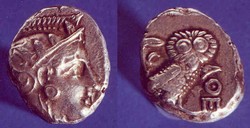
Attic, Athens, ca. 349 B.C. Tetradrachm, silver, diameter 24,5mm, transitional style |
ATHENS
An important stylistic change appears on the “owls” of the IVth century: the eye is no more almond-shaped, but in profile. The style of the face is different, it has less strength and force, while being less frozen.
After the fall of Athens in 404 B.C. and the introduction of the oligarchic government of the Thirty Tyrants under Spartan rule, the city lost its maritime empire, its fleet was confiscated and the Long Walls dismantled. The democracy was restored on the following year, but Athens became withdrawn. Socrat had to drink the hemlock poison (399 B.C.).
Athens recovered its place thanks to Conon. It rested first on the Persians, then allied with Thebes against Sparta (378 B.C.). A new maritime confederation was built up the following year. The Spartans were defeated at Naxos (376 B.C.). Athens signed peace with Sparta and turned against Thebes. After 357 B.C., it had to face a revolt of its allies and the rise of Philippe II of Macedonia, after the fall of Amphipolis. The Athenians were finally defeated in Chaeronea in 338 B.C. and fell under Macedonian domination.
Document CGB, www.cgb.fr
|
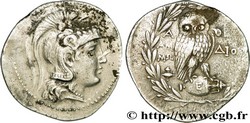
Athens, ca. 182-181 B.C., new style tetradrachm, silver, diameter 33mm |
ATHENS
After the death of Alexander the Great, Athens tried to recover his independence. The Athenians were beaten in Crannon in 322 B.C. Demosthenes committed suicide rather than surrendering to Antipater. After this date, Athens survived only thanks to its past prestige. Cassander took over Athens in 317 B.C. and founded an oligarchic system. It undergo the destiny of Macedonia until the defeat of Pydna in 168 B.C. During the war against Mithridates, Sylla besieged the city which surrendered in 86 B.C.Document CGB, www.cgb.fr
|
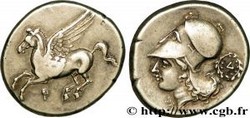
Corinth, ca. 330 B.C., stater, silver, diameter 21mm |
CORINTH
Corinth was the involuntary victim of the Macedonian hegemony on Asia after Alexander the Great, since it then lost its strategic role. Ptolemy Ist occupied it from 308 to 306 B.C. This was the end of the production of the “winged horse” coins. It joined the Achaean league after 268 B.C., but the city was totally destroyed by Lucius Memmius in 146 B.C. because it opposed Rome. Document CGB, www.cgb.fr |
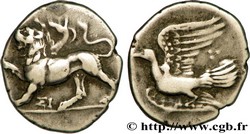
Sikyonia, ca. 330 B.C., hemidrachm, silver, diameter 17,5mm |
SIKYONIA
Sikyonia, on the Peloponnesian bank of the isthmus of Corinth, was the smallest political entity in this area with Phlius, it neighbouring city. Stuck between Achaďa and Argolid, it had been described by Homer in the Iliad as being part of the kingdom of Agamemnon. We have little information on the history of the city before the end of the Persian Wars, except that the area was often devastated by the Athenians, in particular under Pericles in 454 B.C., according to E. Babelon. The coinage became important only after the end of the Peloponnesian War in 404 B.C. Document CGB, www.cgb.fr
|

Caria, Rhodos, ca. 305-274 B.C., didrachm, silver, diameter 17,5mm |
RHODOS
Rhodos, federal capital, was founded in 408 B.C., date where the coinage began. Rhodos was besieged by Demetrius Poliorcetes in 305 B.C. It was a failure. The Rhodians thanked their patron god by raising a statue to him at the entry of the port. Chares of Lindos built the Colossus of Rhodes between 292 and 284 B.C.
It was one of the seven wonders of the world. 33 meters high, it was destroyed by an earthquake in 226 B.C. An oracle forbid the Rhodians to rebuild it. Rhodos, an ally of Rome, freed itself definitively from the Seleucide supervision after 188 B.C.
Document CGB, www.cgb.fr |
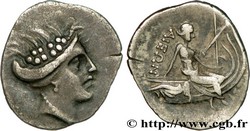
Histeia, ca. 196-168 B.C., tetrobol, silver, diameter 15,5mm |
EUBOIA
Histeia was located in the east of Euboia. Thanks to its important coinage, we can imagine the economic role that the city held. Coins would have been minted to commemorate the eviction, with the help of the Athenians, of the pro-Macedonian tyrant Philistides, in 340 B.C. Histeia seems to have taken a significant importance after the end of the coins production of the Euboďc League in 267 B.C. Its independence was confirmed after 196 B.C. Its coining was largely imitated by the Macedonians and maybe was used for paying the the mercenaries of the Greek army before the battle of Pydna in 168 B.C. After the Macedonian defeat, the city lost its importance and minted only bronze. Document CGB, www.cgb.fr
|
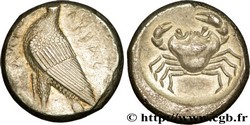
Sicily, Agrigentum, ca 450 B.C., tetradrachm, silver, diameter 24,5mm |
AGRIGENTUM
Agrigentum was founded in the VIth century B.C. by colonists from Gela. The coinage seems to start about 550 B.C. Theron, tyrant of Agrigentum, took over Himera in 482 B.C. Theron and Gelon of Syracuse achieved a brilliant victory over the Carthaginians at Himera in 480 B.C. This released the net that Carthage was tightening on the island. After Theron’s death in 472 B.C., democracy was restored.
In 413, Agrigentum, was rather favorable to the Athenians against Syracuse. The city was destroyed by the Carthaginian invasion of 406 B.C. It nevertheless was rebuilt, but did not regain its former splendour. The Romans took over Agrigentum in 210 B.C., during their conquest of Sicily.
Document CGB, www.cgb.fr
|
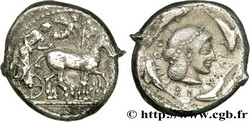
Sicily, Syracuse, ca. 475-470 B.C., tetradrachm, silver, diameter 24,5mm |
SYRACUSE
The government of Syracuse, founded in 733 B.C. by Corinthian colonists was held, from 485 B.C.up, by Gelon, tyrant of Gela since 491 B.C.
He had won a victory at the Olympic Games of 488 B.C. (a chariot race) and recalled this victory by depicting it on the obverse of the Syracusan coins, whereas the reverse showed the head of Arethusa.
This nymph, in mythology, lived on the island of Ortygia, opposite the town of Syracuse, and took the appearance of a fresh water fountain (Virgil, Eclog. IV.1, X.1). Alpheus, a satyr, representing a god-river in the Peloponnese, near Phylace in Arcadia, had pursued Arethusa. Answering her prayer, Artemis changed her into a river and only the sea allowed the nymph to escape the satyr. This legend explains a hydro-geographical phenomenon: an underground river passes under the sea and reemerge on the island of Ortygia. In 480 B.C., the Carthaginians invaded Sicily but were defeated by Gelon at Himera. In 478, Gelon died and his nephew Hieron succeeded to him.
Document CGB, www.cgb.fr |
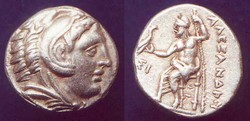
Pella, tetradrachm, Alexander the great coinage |
PELLA
Alexandre III the Great was the son of Philippe II of Macedonia and of Olympias. He was born in 356 B.C., while Philippe’s horses won at the Olympic Games. When his father died, murdered in 336 B.C., he became king of Macedonia at the age of twenty. He crushed immediately the Thebans and destroyed the city which had rebelled. In 334 B.C., he went over to Asia and, after the victory of the Granicus river, sat out to conquer the Achaemenid Empire, going up to Persepolis, and then reaching the doors of India. Back to Babylon, in 325, he married Roxana who gave him a son. Two years later, he died without having fulfilled his ambitions, at the age of 33.
Document CGB, www.cgb.fr
|
|
























